Primary Connections Lesson Plan: Papier Mache Volcano - Year 4 STEM
VerifiedAdded on 2022/10/09
|15
|5774
|19
Homework Assignment
AI Summary
This assignment presents a detailed lesson plan for a Papier Mache Volcano activity designed for Year 4 students, aligning with the Victorian Curriculum Technologies framework. The lesson focuses on engineering principles, material properties, and design specializations. Students will create two-dimensional volcano designs, transforming them into three-dimensional paper mache models. The activity incorporates exploring chemical reactions with Mentos and diet soda to simulate eruptions, along with a 'glow-in-the-dark' effect using tonic water and black light. The lesson plan includes investigation, generating design ideas, producing the models with safety considerations, and evaluating the design process. The lesson emphasizes student collaboration, communication, and the application of STEM concepts. The plan also outlines safety protocols, waste disposal, and assessment methods, including student reflections on their learning and the documentation of the design and production steps. The lesson plan aims to enhance students' communication, individual differences, and collaborative skills within the context of a hands-on STEM project.
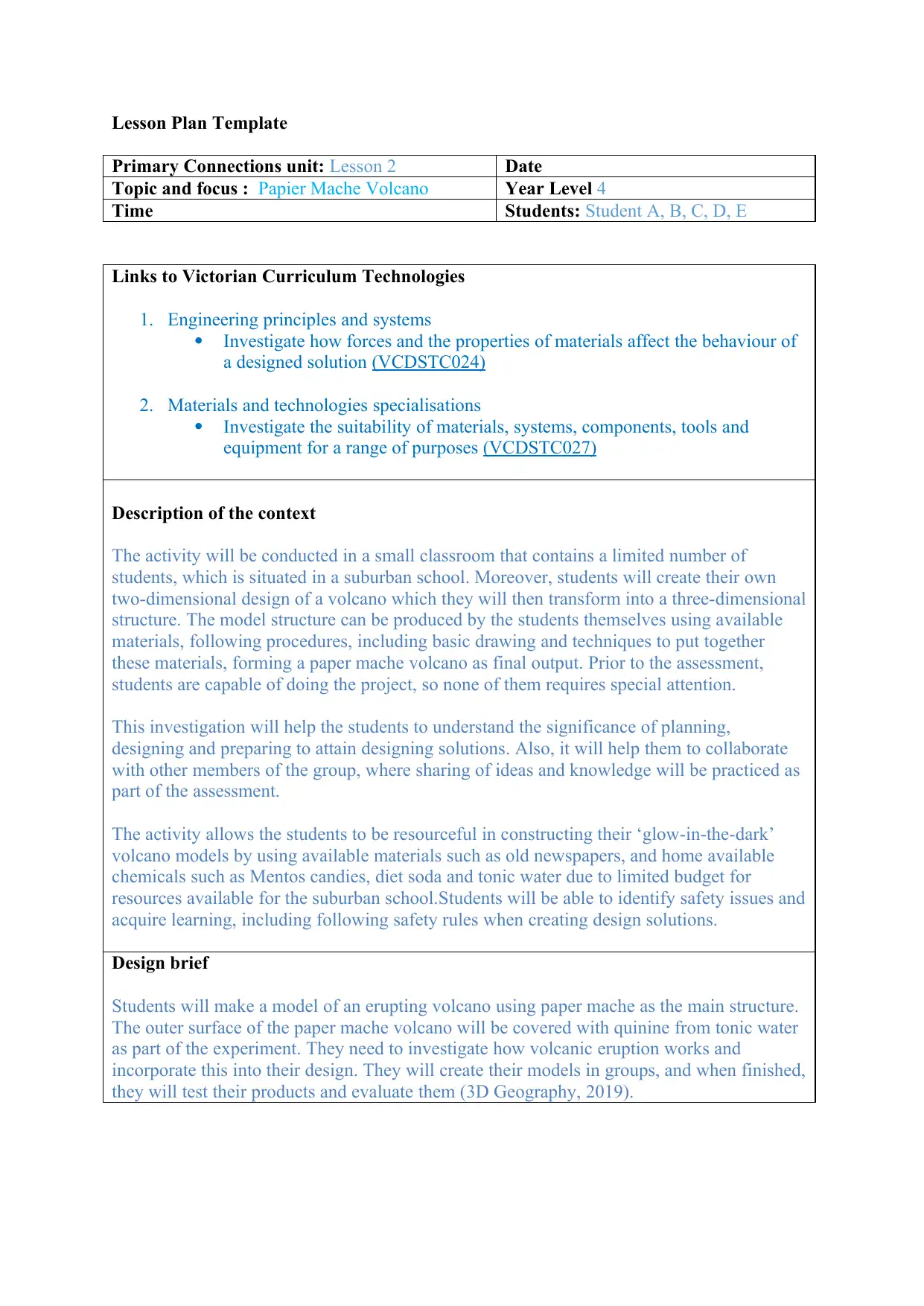
Lesson Plan Template
Primary Connections unit: Lesson 2 Date
Topic and focus : Papier Mache Volcano Year Level 4
Time Students: Student A, B, C, D, E
Links to Victorian Curriculum Technologies
1. Engineering principles and systems
Investigate how forces and the properties of materials affect the behaviour of
a designed solution (VCDSTC024)
2. Materials and technologies specialisations
Investigate the suitability of materials, systems, components, tools and
equipment for a range of purposes (VCDSTC027)
Description of the context
The activity will be conducted in a small classroom that contains a limited number of
students, which is situated in a suburban school. Moreover, students will create their own
two-dimensional design of a volcano which they will then transform into a three-dimensional
structure. The model structure can be produced by the students themselves using available
materials, following procedures, including basic drawing and techniques to put together
these materials, forming a paper mache volcano as final output. Prior to the assessment,
students are capable of doing the project, so none of them requires special attention.
This investigation will help the students to understand the significance of planning,
designing and preparing to attain designing solutions. Also, it will help them to collaborate
with other members of the group, where sharing of ideas and knowledge will be practiced as
part of the assessment.
The activity allows the students to be resourceful in constructing their ‘glow-in-the-dark’
volcano models by using available materials such as old newspapers, and home available
chemicals such as Mentos candies, diet soda and tonic water due to limited budget for
resources available for the suburban school.Students will be able to identify safety issues and
acquire learning, including following safety rules when creating design solutions.
Design brief
Students will make a model of an erupting volcano using paper mache as the main structure.
The outer surface of the paper mache volcano will be covered with quinine from tonic water
as part of the experiment. They need to investigate how volcanic eruption works and
incorporate this into their design. They will create their models in groups, and when finished,
they will test their products and evaluate them (3D Geography, 2019).
Primary Connections unit: Lesson 2 Date
Topic and focus : Papier Mache Volcano Year Level 4
Time Students: Student A, B, C, D, E
Links to Victorian Curriculum Technologies
1. Engineering principles and systems
Investigate how forces and the properties of materials affect the behaviour of
a designed solution (VCDSTC024)
2. Materials and technologies specialisations
Investigate the suitability of materials, systems, components, tools and
equipment for a range of purposes (VCDSTC027)
Description of the context
The activity will be conducted in a small classroom that contains a limited number of
students, which is situated in a suburban school. Moreover, students will create their own
two-dimensional design of a volcano which they will then transform into a three-dimensional
structure. The model structure can be produced by the students themselves using available
materials, following procedures, including basic drawing and techniques to put together
these materials, forming a paper mache volcano as final output. Prior to the assessment,
students are capable of doing the project, so none of them requires special attention.
This investigation will help the students to understand the significance of planning,
designing and preparing to attain designing solutions. Also, it will help them to collaborate
with other members of the group, where sharing of ideas and knowledge will be practiced as
part of the assessment.
The activity allows the students to be resourceful in constructing their ‘glow-in-the-dark’
volcano models by using available materials such as old newspapers, and home available
chemicals such as Mentos candies, diet soda and tonic water due to limited budget for
resources available for the suburban school.Students will be able to identify safety issues and
acquire learning, including following safety rules when creating design solutions.
Design brief
Students will make a model of an erupting volcano using paper mache as the main structure.
The outer surface of the paper mache volcano will be covered with quinine from tonic water
as part of the experiment. They need to investigate how volcanic eruption works and
incorporate this into their design. They will create their models in groups, and when finished,
they will test their products and evaluate them (3D Geography, 2019).
Paraphrase This Document
Need a fresh take? Get an instant paraphrase of this document with our AI Paraphraser
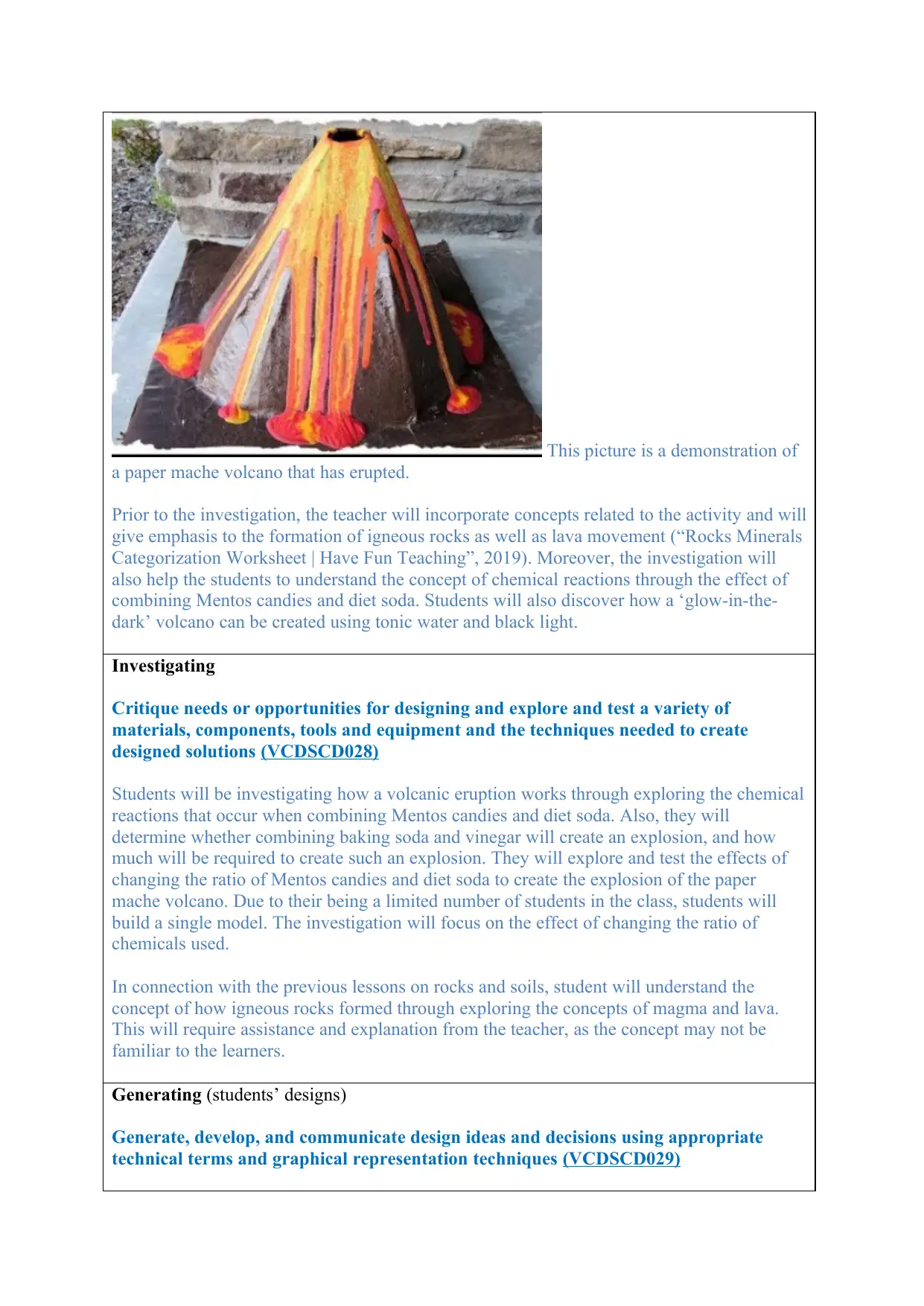
This picture is a demonstration of
a paper mache volcano that has erupted.
Prior to the investigation, the teacher will incorporate concepts related to the activity and will
give emphasis to the formation of igneous rocks as well as lava movement (“Rocks Minerals
Categorization Worksheet | Have Fun Teaching”, 2019). Moreover, the investigation will
also help the students to understand the concept of chemical reactions through the effect of
combining Mentos candies and diet soda. Students will also discover how a ‘glow-in-the-
dark’ volcano can be created using tonic water and black light.
Investigating
Critique needs or opportunities for designing and explore and test a variety of
materials, components, tools and equipment and the techniques needed to create
designed solutions (VCDSCD028)
Students will be investigating how a volcanic eruption works through exploring the chemical
reactions that occur when combining Mentos candies and diet soda. Also, they will
determine whether combining baking soda and vinegar will create an explosion, and how
much will be required to create such an explosion. They will explore and test the effects of
changing the ratio of Mentos candies and diet soda to create the explosion of the paper
mache volcano. Due to their being a limited number of students in the class, students will
build a single model. The investigation will focus on the effect of changing the ratio of
chemicals used.
In connection with the previous lessons on rocks and soils, student will understand the
concept of how igneous rocks formed through exploring the concepts of magma and lava.
This will require assistance and explanation from the teacher, as the concept may not be
familiar to the learners.
Generating (students’ designs)
Generate, develop, and communicate design ideas and decisions using appropriate
technical terms and graphical representation techniques (VCDSCD029)
a paper mache volcano that has erupted.
Prior to the investigation, the teacher will incorporate concepts related to the activity and will
give emphasis to the formation of igneous rocks as well as lava movement (“Rocks Minerals
Categorization Worksheet | Have Fun Teaching”, 2019). Moreover, the investigation will
also help the students to understand the concept of chemical reactions through the effect of
combining Mentos candies and diet soda. Students will also discover how a ‘glow-in-the-
dark’ volcano can be created using tonic water and black light.
Investigating
Critique needs or opportunities for designing and explore and test a variety of
materials, components, tools and equipment and the techniques needed to create
designed solutions (VCDSCD028)
Students will be investigating how a volcanic eruption works through exploring the chemical
reactions that occur when combining Mentos candies and diet soda. Also, they will
determine whether combining baking soda and vinegar will create an explosion, and how
much will be required to create such an explosion. They will explore and test the effects of
changing the ratio of Mentos candies and diet soda to create the explosion of the paper
mache volcano. Due to their being a limited number of students in the class, students will
build a single model. The investigation will focus on the effect of changing the ratio of
chemicals used.
In connection with the previous lessons on rocks and soils, student will understand the
concept of how igneous rocks formed through exploring the concepts of magma and lava.
This will require assistance and explanation from the teacher, as the concept may not be
familiar to the learners.
Generating (students’ designs)
Generate, develop, and communicate design ideas and decisions using appropriate
technical terms and graphical representation techniques (VCDSCD029)
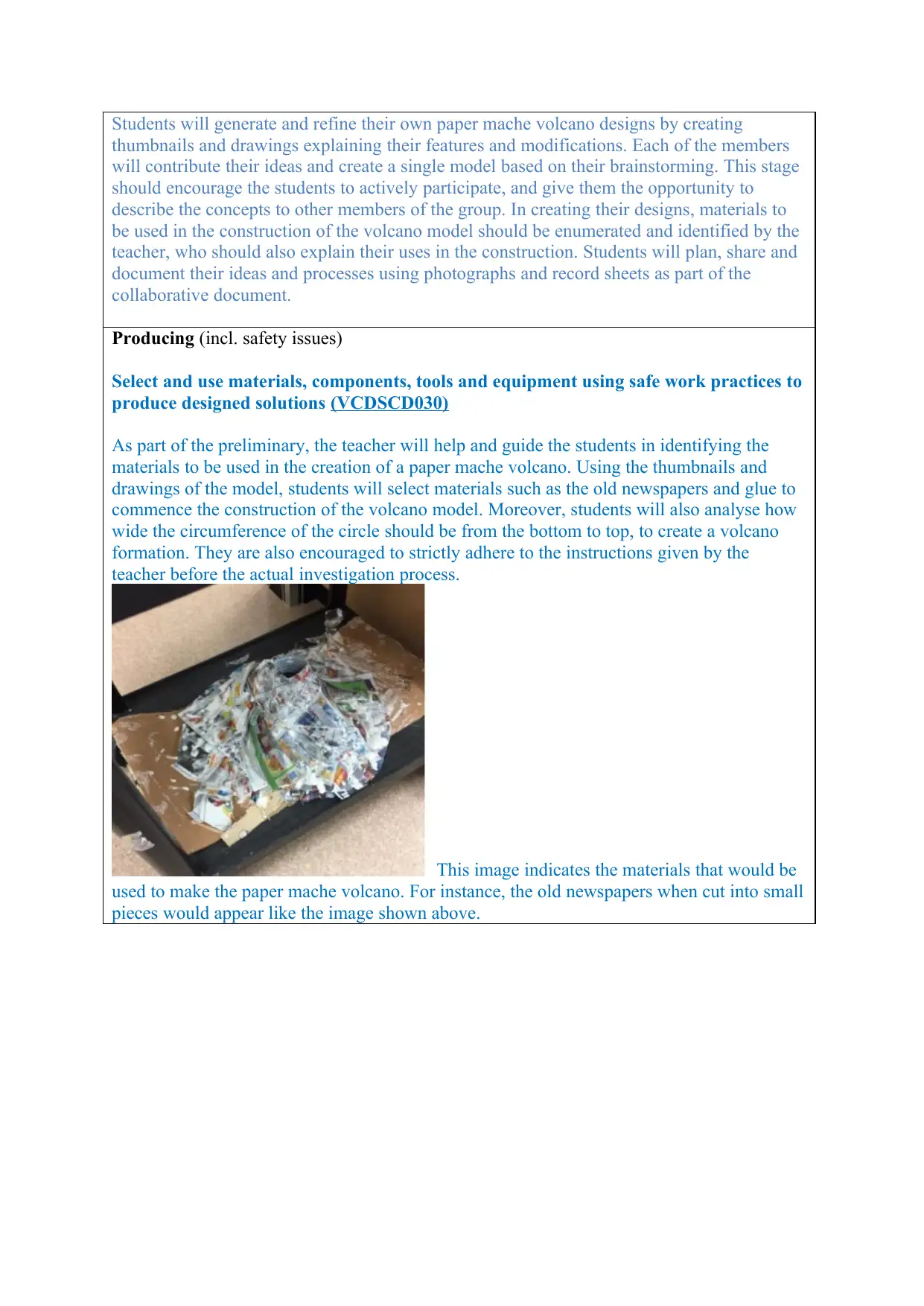
Students will generate and refine their own paper mache volcano designs by creating
thumbnails and drawings explaining their features and modifications. Each of the members
will contribute their ideas and create a single model based on their brainstorming. This stage
should encourage the students to actively participate, and give them the opportunity to
describe the concepts to other members of the group. In creating their designs, materials to
be used in the construction of the volcano model should be enumerated and identified by the
teacher, who should also explain their uses in the construction. Students will plan, share and
document their ideas and processes using photographs and record sheets as part of the
collaborative document.
Producing (incl. safety issues)
Select and use materials, components, tools and equipment using safe work practices to
produce designed solutions (VCDSCD030)
As part of the preliminary, the teacher will help and guide the students in identifying the
materials to be used in the creation of a paper mache volcano. Using the thumbnails and
drawings of the model, students will select materials such as the old newspapers and glue to
commence the construction of the volcano model. Moreover, students will also analyse how
wide the circumference of the circle should be from the bottom to top, to create a volcano
formation. They are also encouraged to strictly adhere to the instructions given by the
teacher before the actual investigation process.
This image indicates the materials that would be
used to make the paper mache volcano. For instance, the old newspapers when cut into small
pieces would appear like the image shown above.
thumbnails and drawings explaining their features and modifications. Each of the members
will contribute their ideas and create a single model based on their brainstorming. This stage
should encourage the students to actively participate, and give them the opportunity to
describe the concepts to other members of the group. In creating their designs, materials to
be used in the construction of the volcano model should be enumerated and identified by the
teacher, who should also explain their uses in the construction. Students will plan, share and
document their ideas and processes using photographs and record sheets as part of the
collaborative document.
Producing (incl. safety issues)
Select and use materials, components, tools and equipment using safe work practices to
produce designed solutions (VCDSCD030)
As part of the preliminary, the teacher will help and guide the students in identifying the
materials to be used in the creation of a paper mache volcano. Using the thumbnails and
drawings of the model, students will select materials such as the old newspapers and glue to
commence the construction of the volcano model. Moreover, students will also analyse how
wide the circumference of the circle should be from the bottom to top, to create a volcano
formation. They are also encouraged to strictly adhere to the instructions given by the
teacher before the actual investigation process.
This image indicates the materials that would be
used to make the paper mache volcano. For instance, the old newspapers when cut into small
pieces would appear like the image shown above.
⊘ This is a preview!⊘
Do you want full access?
Subscribe today to unlock all pages.

Trusted by 1+ million students worldwide
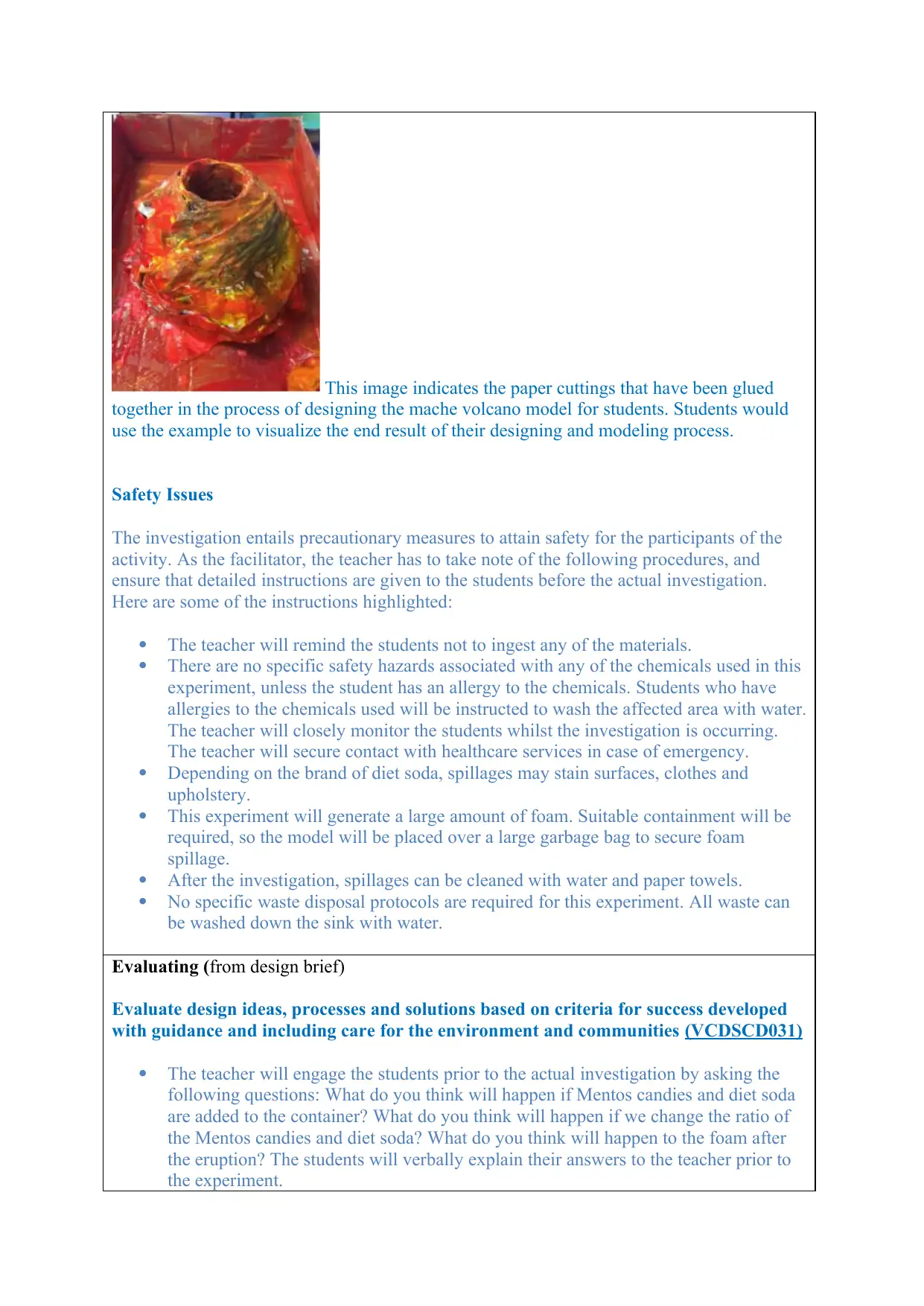
This image indicates the paper cuttings that have been glued
together in the process of designing the mache volcano model for students. Students would
use the example to visualize the end result of their designing and modeling process.
Safety Issues
The investigation entails precautionary measures to attain safety for the participants of the
activity. As the facilitator, the teacher has to take note of the following procedures, and
ensure that detailed instructions are given to the students before the actual investigation.
Here are some of the instructions highlighted:
The teacher will remind the students not to ingest any of the materials.
There are no specific safety hazards associated with any of the chemicals used in this
experiment, unless the student has an allergy to the chemicals. Students who have
allergies to the chemicals used will be instructed to wash the affected area with water.
The teacher will closely monitor the students whilst the investigation is occurring.
The teacher will secure contact with healthcare services in case of emergency.
Depending on the brand of diet soda, spillages may stain surfaces, clothes and
upholstery.
This experiment will generate a large amount of foam. Suitable containment will be
required, so the model will be placed over a large garbage bag to secure foam
spillage.
After the investigation, spillages can be cleaned with water and paper towels.
No specific waste disposal protocols are required for this experiment. All waste can
be washed down the sink with water.
Evaluating (from design brief)
Evaluate design ideas, processes and solutions based on criteria for success developed
with guidance and including care for the environment and communities (VCDSCD031)
The teacher will engage the students prior to the actual investigation by asking the
following questions: What do you think will happen if Mentos candies and diet soda
are added to the container? What do you think will happen if we change the ratio of
the Mentos candies and diet soda? What do you think will happen to the foam after
the eruption? The students will verbally explain their answers to the teacher prior to
the experiment.
together in the process of designing the mache volcano model for students. Students would
use the example to visualize the end result of their designing and modeling process.
Safety Issues
The investigation entails precautionary measures to attain safety for the participants of the
activity. As the facilitator, the teacher has to take note of the following procedures, and
ensure that detailed instructions are given to the students before the actual investigation.
Here are some of the instructions highlighted:
The teacher will remind the students not to ingest any of the materials.
There are no specific safety hazards associated with any of the chemicals used in this
experiment, unless the student has an allergy to the chemicals. Students who have
allergies to the chemicals used will be instructed to wash the affected area with water.
The teacher will closely monitor the students whilst the investigation is occurring.
The teacher will secure contact with healthcare services in case of emergency.
Depending on the brand of diet soda, spillages may stain surfaces, clothes and
upholstery.
This experiment will generate a large amount of foam. Suitable containment will be
required, so the model will be placed over a large garbage bag to secure foam
spillage.
After the investigation, spillages can be cleaned with water and paper towels.
No specific waste disposal protocols are required for this experiment. All waste can
be washed down the sink with water.
Evaluating (from design brief)
Evaluate design ideas, processes and solutions based on criteria for success developed
with guidance and including care for the environment and communities (VCDSCD031)
The teacher will engage the students prior to the actual investigation by asking the
following questions: What do you think will happen if Mentos candies and diet soda
are added to the container? What do you think will happen if we change the ratio of
the Mentos candies and diet soda? What do you think will happen to the foam after
the eruption? The students will verbally explain their answers to the teacher prior to
the experiment.
Paraphrase This Document
Need a fresh take? Get an instant paraphrase of this document with our AI Paraphraser
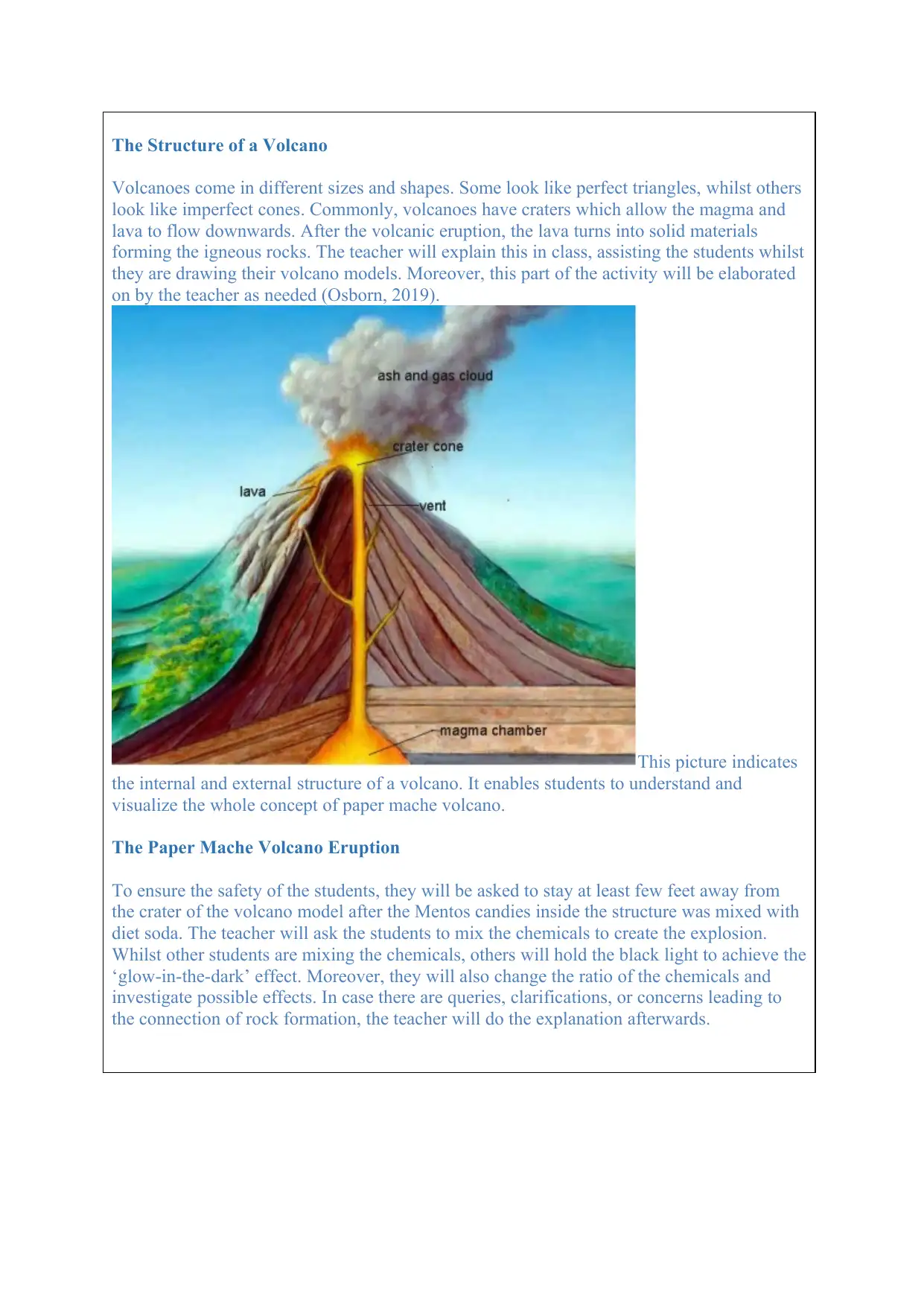
The Structure of a Volcano
Volcanoes come in different sizes and shapes. Some look like perfect triangles, whilst others
look like imperfect cones. Commonly, volcanoes have craters which allow the magma and
lava to flow downwards. After the volcanic eruption, the lava turns into solid materials
forming the igneous rocks. The teacher will explain this in class, assisting the students whilst
they are drawing their volcano models. Moreover, this part of the activity will be elaborated
on by the teacher as needed (Osborn, 2019).
This picture indicates
the internal and external structure of a volcano. It enables students to understand and
visualize the whole concept of paper mache volcano.
The Paper Mache Volcano Eruption
To ensure the safety of the students, they will be asked to stay at least few feet away from
the crater of the volcano model after the Mentos candies inside the structure was mixed with
diet soda. The teacher will ask the students to mix the chemicals to create the explosion.
Whilst other students are mixing the chemicals, others will hold the black light to achieve the
‘glow-in-the-dark’ effect. Moreover, they will also change the ratio of the chemicals and
investigate possible effects. In case there are queries, clarifications, or concerns leading to
the connection of rock formation, the teacher will do the explanation afterwards.
Volcanoes come in different sizes and shapes. Some look like perfect triangles, whilst others
look like imperfect cones. Commonly, volcanoes have craters which allow the magma and
lava to flow downwards. After the volcanic eruption, the lava turns into solid materials
forming the igneous rocks. The teacher will explain this in class, assisting the students whilst
they are drawing their volcano models. Moreover, this part of the activity will be elaborated
on by the teacher as needed (Osborn, 2019).
This picture indicates
the internal and external structure of a volcano. It enables students to understand and
visualize the whole concept of paper mache volcano.
The Paper Mache Volcano Eruption
To ensure the safety of the students, they will be asked to stay at least few feet away from
the crater of the volcano model after the Mentos candies inside the structure was mixed with
diet soda. The teacher will ask the students to mix the chemicals to create the explosion.
Whilst other students are mixing the chemicals, others will hold the black light to achieve the
‘glow-in-the-dark’ effect. Moreover, they will also change the ratio of the chemicals and
investigate possible effects. In case there are queries, clarifications, or concerns leading to
the connection of rock formation, the teacher will do the explanation afterwards.
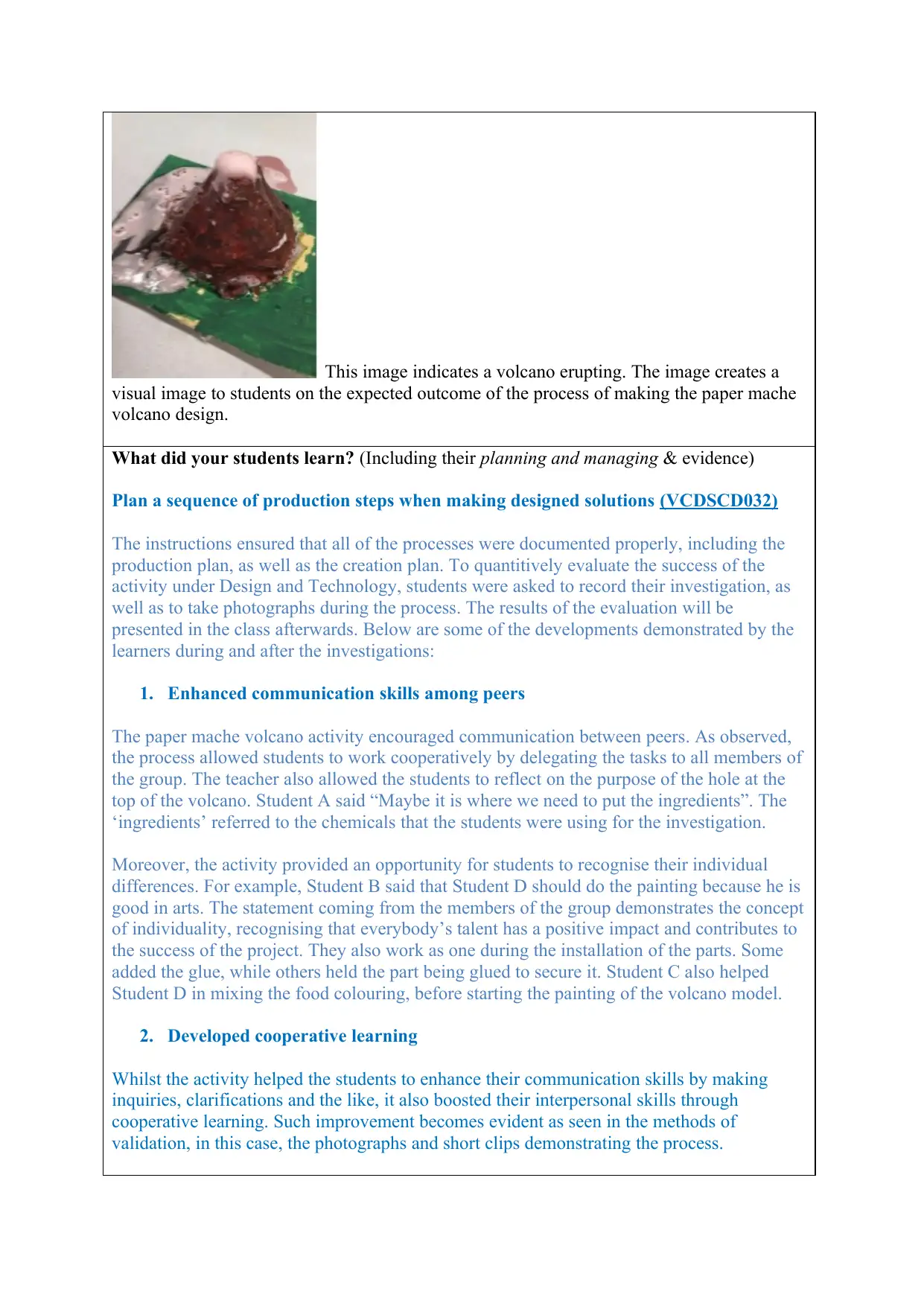
This image indicates a volcano erupting. The image creates a
visual image to students on the expected outcome of the process of making the paper mache
volcano design.
What did your students learn? (Including their planning and managing & evidence)
Plan a sequence of production steps when making designed solutions (VCDSCD032)
The instructions ensured that all of the processes were documented properly, including the
production plan, as well as the creation plan. To quantitively evaluate the success of the
activity under Design and Technology, students were asked to record their investigation, as
well as to take photographs during the process. The results of the evaluation will be
presented in the class afterwards. Below are some of the developments demonstrated by the
learners during and after the investigations:
1. Enhanced communication skills among peers
The paper mache volcano activity encouraged communication between peers. As observed,
the process allowed students to work cooperatively by delegating the tasks to all members of
the group. The teacher also allowed the students to reflect on the purpose of the hole at the
top of the volcano. Student A said “Maybe it is where we need to put the ingredients”. The
‘ingredients’ referred to the chemicals that the students were using for the investigation.
Moreover, the activity provided an opportunity for students to recognise their individual
differences. For example, Student B said that Student D should do the painting because he is
good in arts. The statement coming from the members of the group demonstrates the concept
of individuality, recognising that everybody’s talent has a positive impact and contributes to
the success of the project. They also work as one during the installation of the parts. Some
added the glue, while others held the part being glued to secure it. Student C also helped
Student D in mixing the food colouring, before starting the painting of the volcano model.
2. Developed cooperative learning
Whilst the activity helped the students to enhance their communication skills by making
inquiries, clarifications and the like, it also boosted their interpersonal skills through
cooperative learning. Such improvement becomes evident as seen in the methods of
validation, in this case, the photographs and short clips demonstrating the process.
visual image to students on the expected outcome of the process of making the paper mache
volcano design.
What did your students learn? (Including their planning and managing & evidence)
Plan a sequence of production steps when making designed solutions (VCDSCD032)
The instructions ensured that all of the processes were documented properly, including the
production plan, as well as the creation plan. To quantitively evaluate the success of the
activity under Design and Technology, students were asked to record their investigation, as
well as to take photographs during the process. The results of the evaluation will be
presented in the class afterwards. Below are some of the developments demonstrated by the
learners during and after the investigations:
1. Enhanced communication skills among peers
The paper mache volcano activity encouraged communication between peers. As observed,
the process allowed students to work cooperatively by delegating the tasks to all members of
the group. The teacher also allowed the students to reflect on the purpose of the hole at the
top of the volcano. Student A said “Maybe it is where we need to put the ingredients”. The
‘ingredients’ referred to the chemicals that the students were using for the investigation.
Moreover, the activity provided an opportunity for students to recognise their individual
differences. For example, Student B said that Student D should do the painting because he is
good in arts. The statement coming from the members of the group demonstrates the concept
of individuality, recognising that everybody’s talent has a positive impact and contributes to
the success of the project. They also work as one during the installation of the parts. Some
added the glue, while others held the part being glued to secure it. Student C also helped
Student D in mixing the food colouring, before starting the painting of the volcano model.
2. Developed cooperative learning
Whilst the activity helped the students to enhance their communication skills by making
inquiries, clarifications and the like, it also boosted their interpersonal skills through
cooperative learning. Such improvement becomes evident as seen in the methods of
validation, in this case, the photographs and short clips demonstrating the process.
⊘ This is a preview!⊘
Do you want full access?
Subscribe today to unlock all pages.

Trusted by 1+ million students worldwide
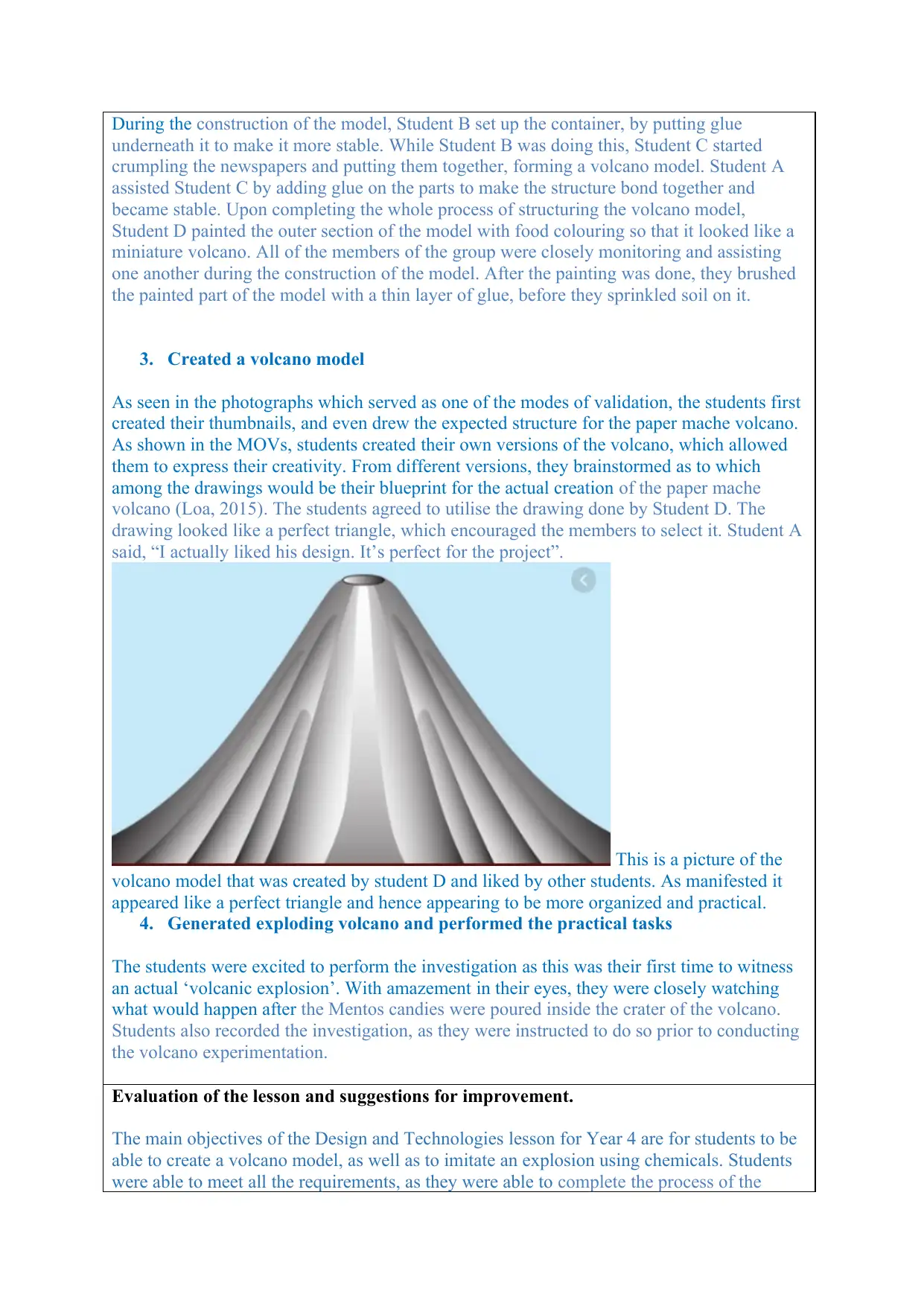
During the construction of the model, Student B set up the container, by putting glue
underneath it to make it more stable. While Student B was doing this, Student C started
crumpling the newspapers and putting them together, forming a volcano model. Student A
assisted Student C by adding glue on the parts to make the structure bond together and
became stable. Upon completing the whole process of structuring the volcano model,
Student D painted the outer section of the model with food colouring so that it looked like a
miniature volcano. All of the members of the group were closely monitoring and assisting
one another during the construction of the model. After the painting was done, they brushed
the painted part of the model with a thin layer of glue, before they sprinkled soil on it.
3. Created a volcano model
As seen in the photographs which served as one of the modes of validation, the students first
created their thumbnails, and even drew the expected structure for the paper mache volcano.
As shown in the MOVs, students created their own versions of the volcano, which allowed
them to express their creativity. From different versions, they brainstormed as to which
among the drawings would be their blueprint for the actual creation of the paper mache
volcano (Loa, 2015). The students agreed to utilise the drawing done by Student D. The
drawing looked like a perfect triangle, which encouraged the members to select it. Student A
said, “I actually liked his design. It’s perfect for the project”.
This is a picture of the
volcano model that was created by student D and liked by other students. As manifested it
appeared like a perfect triangle and hence appearing to be more organized and practical.
4. Generated exploding volcano and performed the practical tasks
The students were excited to perform the investigation as this was their first time to witness
an actual ‘volcanic explosion’. With amazement in their eyes, they were closely watching
what would happen after the Mentos candies were poured inside the crater of the volcano.
Students also recorded the investigation, as they were instructed to do so prior to conducting
the volcano experimentation.
Evaluation of the lesson and suggestions for improvement.
The main objectives of the Design and Technologies lesson for Year 4 are for students to be
able to create a volcano model, as well as to imitate an explosion using chemicals. Students
were able to meet all the requirements, as they were able to complete the process of the
underneath it to make it more stable. While Student B was doing this, Student C started
crumpling the newspapers and putting them together, forming a volcano model. Student A
assisted Student C by adding glue on the parts to make the structure bond together and
became stable. Upon completing the whole process of structuring the volcano model,
Student D painted the outer section of the model with food colouring so that it looked like a
miniature volcano. All of the members of the group were closely monitoring and assisting
one another during the construction of the model. After the painting was done, they brushed
the painted part of the model with a thin layer of glue, before they sprinkled soil on it.
3. Created a volcano model
As seen in the photographs which served as one of the modes of validation, the students first
created their thumbnails, and even drew the expected structure for the paper mache volcano.
As shown in the MOVs, students created their own versions of the volcano, which allowed
them to express their creativity. From different versions, they brainstormed as to which
among the drawings would be their blueprint for the actual creation of the paper mache
volcano (Loa, 2015). The students agreed to utilise the drawing done by Student D. The
drawing looked like a perfect triangle, which encouraged the members to select it. Student A
said, “I actually liked his design. It’s perfect for the project”.
This is a picture of the
volcano model that was created by student D and liked by other students. As manifested it
appeared like a perfect triangle and hence appearing to be more organized and practical.
4. Generated exploding volcano and performed the practical tasks
The students were excited to perform the investigation as this was their first time to witness
an actual ‘volcanic explosion’. With amazement in their eyes, they were closely watching
what would happen after the Mentos candies were poured inside the crater of the volcano.
Students also recorded the investigation, as they were instructed to do so prior to conducting
the volcano experimentation.
Evaluation of the lesson and suggestions for improvement.
The main objectives of the Design and Technologies lesson for Year 4 are for students to be
able to create a volcano model, as well as to imitate an explosion using chemicals. Students
were able to meet all the requirements, as they were able to complete the process of the
Paraphrase This Document
Need a fresh take? Get an instant paraphrase of this document with our AI Paraphraser
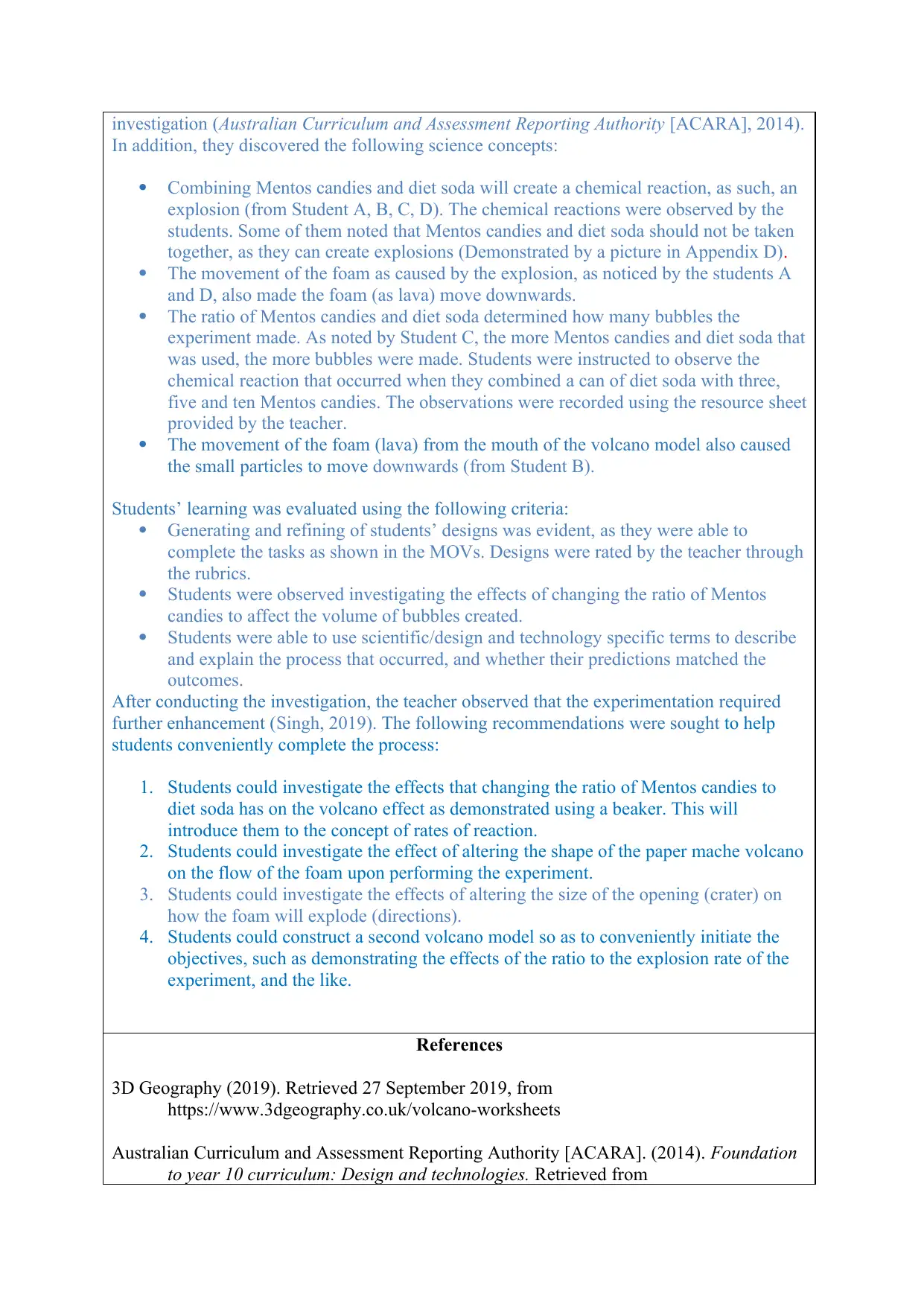
investigation (Australian Curriculum and Assessment Reporting Authority [ACARA], 2014).
In addition, they discovered the following science concepts:
Combining Mentos candies and diet soda will create a chemical reaction, as such, an
explosion (from Student A, B, C, D). The chemical reactions were observed by the
students. Some of them noted that Mentos candies and diet soda should not be taken
together, as they can create explosions (Demonstrated by a picture in Appendix D).
The movement of the foam as caused by the explosion, as noticed by the students A
and D, also made the foam (as lava) move downwards.
The ratio of Mentos candies and diet soda determined how many bubbles the
experiment made. As noted by Student C, the more Mentos candies and diet soda that
was used, the more bubbles were made. Students were instructed to observe the
chemical reaction that occurred when they combined a can of diet soda with three,
five and ten Mentos candies. The observations were recorded using the resource sheet
provided by the teacher.
The movement of the foam (lava) from the mouth of the volcano model also caused
the small particles to move downwards (from Student B).
Students’ learning was evaluated using the following criteria:
Generating and refining of students’ designs was evident, as they were able to
complete the tasks as shown in the MOVs. Designs were rated by the teacher through
the rubrics.
Students were observed investigating the effects of changing the ratio of Mentos
candies to affect the volume of bubbles created.
Students were able to use scientific/design and technology specific terms to describe
and explain the process that occurred, and whether their predictions matched the
outcomes.
After conducting the investigation, the teacher observed that the experimentation required
further enhancement (Singh, 2019). The following recommendations were sought to help
students conveniently complete the process:
1. Students could investigate the effects that changing the ratio of Mentos candies to
diet soda has on the volcano effect as demonstrated using a beaker. This will
introduce them to the concept of rates of reaction.
2. Students could investigate the effect of altering the shape of the paper mache volcano
on the flow of the foam upon performing the experiment.
3. Students could investigate the effects of altering the size of the opening (crater) on
how the foam will explode (directions).
4. Students could construct a second volcano model so as to conveniently initiate the
objectives, such as demonstrating the effects of the ratio to the explosion rate of the
experiment, and the like.
References
3D Geography (2019). Retrieved 27 September 2019, from
https://www.3dgeography.co.uk/volcano-worksheets
Australian Curriculum and Assessment Reporting Authority [ACARA]. (2014). Foundation
to year 10 curriculum: Design and technologies. Retrieved from
In addition, they discovered the following science concepts:
Combining Mentos candies and diet soda will create a chemical reaction, as such, an
explosion (from Student A, B, C, D). The chemical reactions were observed by the
students. Some of them noted that Mentos candies and diet soda should not be taken
together, as they can create explosions (Demonstrated by a picture in Appendix D).
The movement of the foam as caused by the explosion, as noticed by the students A
and D, also made the foam (as lava) move downwards.
The ratio of Mentos candies and diet soda determined how many bubbles the
experiment made. As noted by Student C, the more Mentos candies and diet soda that
was used, the more bubbles were made. Students were instructed to observe the
chemical reaction that occurred when they combined a can of diet soda with three,
five and ten Mentos candies. The observations were recorded using the resource sheet
provided by the teacher.
The movement of the foam (lava) from the mouth of the volcano model also caused
the small particles to move downwards (from Student B).
Students’ learning was evaluated using the following criteria:
Generating and refining of students’ designs was evident, as they were able to
complete the tasks as shown in the MOVs. Designs were rated by the teacher through
the rubrics.
Students were observed investigating the effects of changing the ratio of Mentos
candies to affect the volume of bubbles created.
Students were able to use scientific/design and technology specific terms to describe
and explain the process that occurred, and whether their predictions matched the
outcomes.
After conducting the investigation, the teacher observed that the experimentation required
further enhancement (Singh, 2019). The following recommendations were sought to help
students conveniently complete the process:
1. Students could investigate the effects that changing the ratio of Mentos candies to
diet soda has on the volcano effect as demonstrated using a beaker. This will
introduce them to the concept of rates of reaction.
2. Students could investigate the effect of altering the shape of the paper mache volcano
on the flow of the foam upon performing the experiment.
3. Students could investigate the effects of altering the size of the opening (crater) on
how the foam will explode (directions).
4. Students could construct a second volcano model so as to conveniently initiate the
objectives, such as demonstrating the effects of the ratio to the explosion rate of the
experiment, and the like.
References
3D Geography (2019). Retrieved 27 September 2019, from
https://www.3dgeography.co.uk/volcano-worksheets
Australian Curriculum and Assessment Reporting Authority [ACARA]. (2014). Foundation
to year 10 curriculum: Design and technologies. Retrieved from
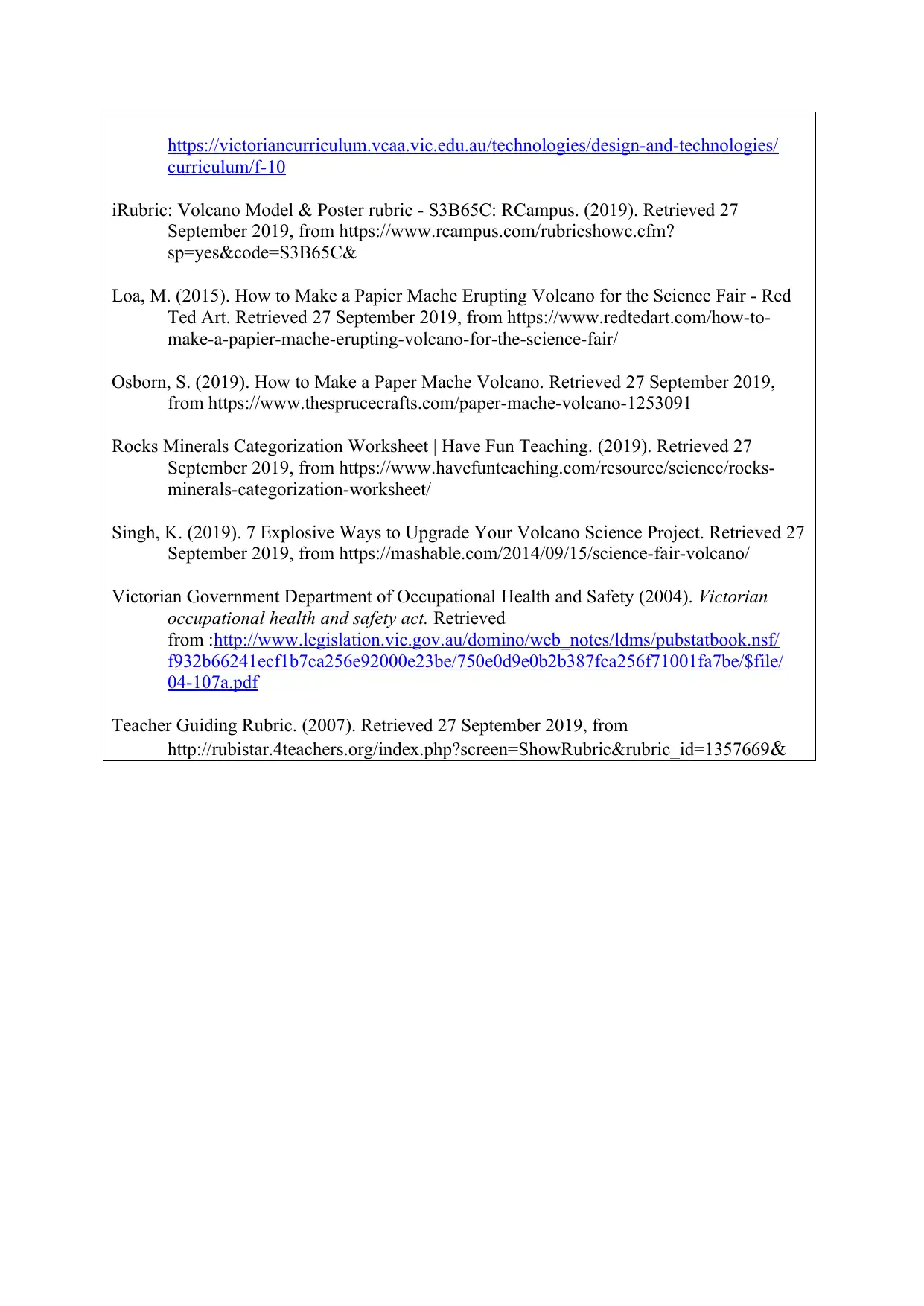
https://victoriancurriculum.vcaa.vic.edu.au/technologies/design-and-technologies/
curriculum/f-10
iRubric: Volcano Model & Poster rubric - S3B65C: RCampus. (2019). Retrieved 27
September 2019, from https://www.rcampus.com/rubricshowc.cfm?
sp=yes&code=S3B65C&
Loa, M. (2015). How to Make a Papier Mache Erupting Volcano for the Science Fair - Red
Ted Art. Retrieved 27 September 2019, from https://www.redtedart.com/how-to-
make-a-papier-mache-erupting-volcano-for-the-science-fair/
Osborn, S. (2019). How to Make a Paper Mache Volcano. Retrieved 27 September 2019,
from https://www.thesprucecrafts.com/paper-mache-volcano-1253091
Rocks Minerals Categorization Worksheet | Have Fun Teaching. (2019). Retrieved 27
September 2019, from https://www.havefunteaching.com/resource/science/rocks-
minerals-categorization-worksheet/
Singh, K. (2019). 7 Explosive Ways to Upgrade Your Volcano Science Project. Retrieved 27
September 2019, from https://mashable.com/2014/09/15/science-fair-volcano/
Victorian Government Department of Occupational Health and Safety (2004). Victorian
occupational health and safety act. Retrieved
from :http://www.legislation.vic.gov.au/domino/web_notes/ldms/pubstatbook.nsf/
f932b66241ecf1b7ca256e92000e23be/750e0d9e0b2b387fca256f71001fa7be/$file/
04-107a.pdf
Teacher Guiding Rubric. (2007). Retrieved 27 September 2019, from
http://rubistar.4teachers.org/index.php?screen=ShowRubric&rubric_id=1357669&
curriculum/f-10
iRubric: Volcano Model & Poster rubric - S3B65C: RCampus. (2019). Retrieved 27
September 2019, from https://www.rcampus.com/rubricshowc.cfm?
sp=yes&code=S3B65C&
Loa, M. (2015). How to Make a Papier Mache Erupting Volcano for the Science Fair - Red
Ted Art. Retrieved 27 September 2019, from https://www.redtedart.com/how-to-
make-a-papier-mache-erupting-volcano-for-the-science-fair/
Osborn, S. (2019). How to Make a Paper Mache Volcano. Retrieved 27 September 2019,
from https://www.thesprucecrafts.com/paper-mache-volcano-1253091
Rocks Minerals Categorization Worksheet | Have Fun Teaching. (2019). Retrieved 27
September 2019, from https://www.havefunteaching.com/resource/science/rocks-
minerals-categorization-worksheet/
Singh, K. (2019). 7 Explosive Ways to Upgrade Your Volcano Science Project. Retrieved 27
September 2019, from https://mashable.com/2014/09/15/science-fair-volcano/
Victorian Government Department of Occupational Health and Safety (2004). Victorian
occupational health and safety act. Retrieved
from :http://www.legislation.vic.gov.au/domino/web_notes/ldms/pubstatbook.nsf/
f932b66241ecf1b7ca256e92000e23be/750e0d9e0b2b387fca256f71001fa7be/$file/
04-107a.pdf
Teacher Guiding Rubric. (2007). Retrieved 27 September 2019, from
http://rubistar.4teachers.org/index.php?screen=ShowRubric&rubric_id=1357669&
⊘ This is a preview!⊘
Do you want full access?
Subscribe today to unlock all pages.

Trusted by 1+ million students worldwide
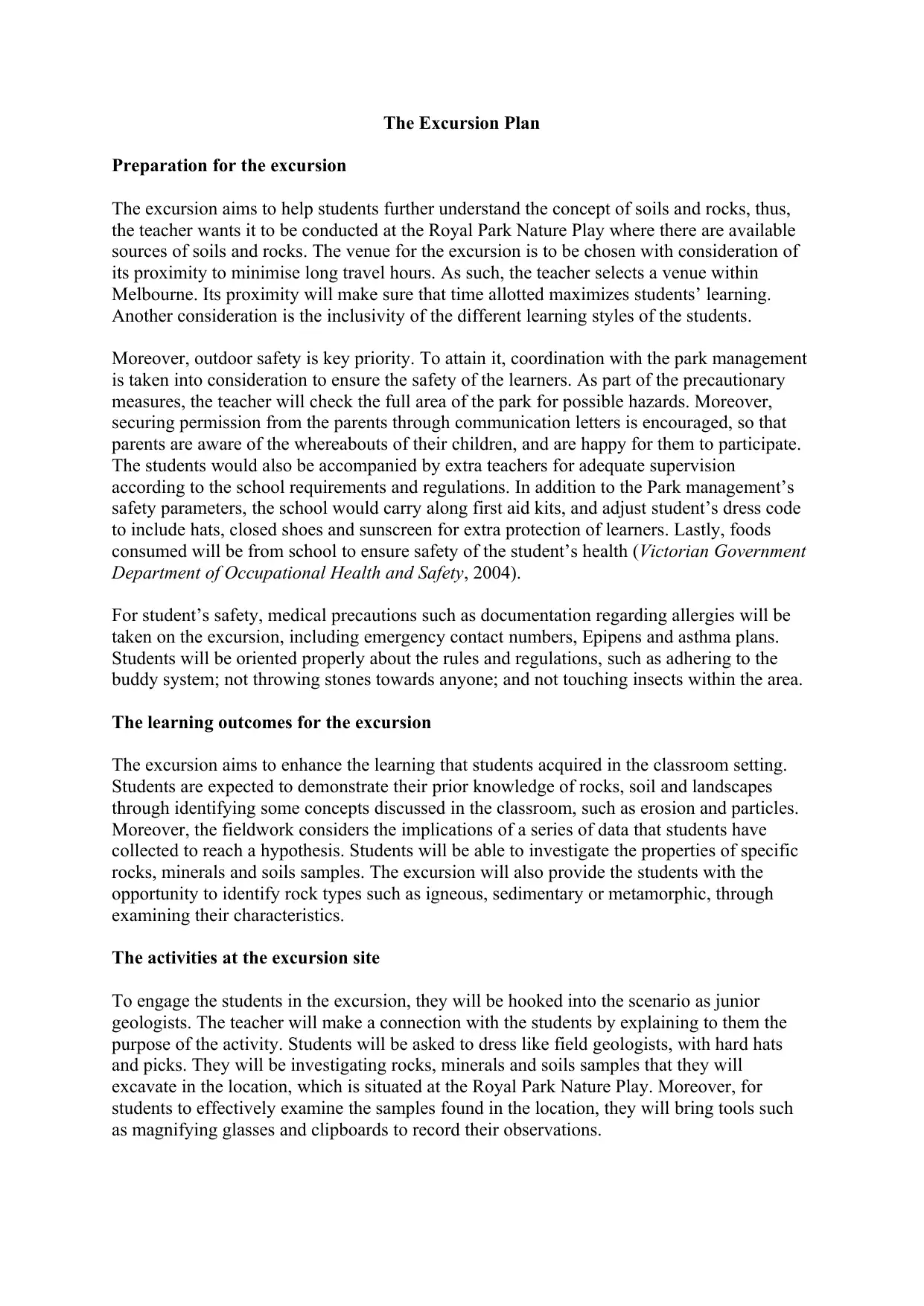
The Excursion Plan
Preparation for the excursion
The excursion aims to help students further understand the concept of soils and rocks, thus,
the teacher wants it to be conducted at the Royal Park Nature Play where there are available
sources of soils and rocks. The venue for the excursion is to be chosen with consideration of
its proximity to minimise long travel hours. As such, the teacher selects a venue within
Melbourne. Its proximity will make sure that time allotted maximizes students’ learning.
Another consideration is the inclusivity of the different learning styles of the students.
Moreover, outdoor safety is key priority. To attain it, coordination with the park management
is taken into consideration to ensure the safety of the learners. As part of the precautionary
measures, the teacher will check the full area of the park for possible hazards. Moreover,
securing permission from the parents through communication letters is encouraged, so that
parents are aware of the whereabouts of their children, and are happy for them to participate.
The students would also be accompanied by extra teachers for adequate supervision
according to the school requirements and regulations. In addition to the Park management’s
safety parameters, the school would carry along first aid kits, and adjust student’s dress code
to include hats, closed shoes and sunscreen for extra protection of learners. Lastly, foods
consumed will be from school to ensure safety of the student’s health (Victorian Government
Department of Occupational Health and Safety, 2004).
For student’s safety, medical precautions such as documentation regarding allergies will be
taken on the excursion, including emergency contact numbers, Epipens and asthma plans.
Students will be oriented properly about the rules and regulations, such as adhering to the
buddy system; not throwing stones towards anyone; and not touching insects within the area.
The learning outcomes for the excursion
The excursion aims to enhance the learning that students acquired in the classroom setting.
Students are expected to demonstrate their prior knowledge of rocks, soil and landscapes
through identifying some concepts discussed in the classroom, such as erosion and particles.
Moreover, the fieldwork considers the implications of a series of data that students have
collected to reach a hypothesis. Students will be able to investigate the properties of specific
rocks, minerals and soils samples. The excursion will also provide the students with the
opportunity to identify rock types such as igneous, sedimentary or metamorphic, through
examining their characteristics.
The activities at the excursion site
To engage the students in the excursion, they will be hooked into the scenario as junior
geologists. The teacher will make a connection with the students by explaining to them the
purpose of the activity. Students will be asked to dress like field geologists, with hard hats
and picks. They will be investigating rocks, minerals and soils samples that they will
excavate in the location, which is situated at the Royal Park Nature Play. Moreover, for
students to effectively examine the samples found in the location, they will bring tools such
as magnifying glasses and clipboards to record their observations.
Preparation for the excursion
The excursion aims to help students further understand the concept of soils and rocks, thus,
the teacher wants it to be conducted at the Royal Park Nature Play where there are available
sources of soils and rocks. The venue for the excursion is to be chosen with consideration of
its proximity to minimise long travel hours. As such, the teacher selects a venue within
Melbourne. Its proximity will make sure that time allotted maximizes students’ learning.
Another consideration is the inclusivity of the different learning styles of the students.
Moreover, outdoor safety is key priority. To attain it, coordination with the park management
is taken into consideration to ensure the safety of the learners. As part of the precautionary
measures, the teacher will check the full area of the park for possible hazards. Moreover,
securing permission from the parents through communication letters is encouraged, so that
parents are aware of the whereabouts of their children, and are happy for them to participate.
The students would also be accompanied by extra teachers for adequate supervision
according to the school requirements and regulations. In addition to the Park management’s
safety parameters, the school would carry along first aid kits, and adjust student’s dress code
to include hats, closed shoes and sunscreen for extra protection of learners. Lastly, foods
consumed will be from school to ensure safety of the student’s health (Victorian Government
Department of Occupational Health and Safety, 2004).
For student’s safety, medical precautions such as documentation regarding allergies will be
taken on the excursion, including emergency contact numbers, Epipens and asthma plans.
Students will be oriented properly about the rules and regulations, such as adhering to the
buddy system; not throwing stones towards anyone; and not touching insects within the area.
The learning outcomes for the excursion
The excursion aims to enhance the learning that students acquired in the classroom setting.
Students are expected to demonstrate their prior knowledge of rocks, soil and landscapes
through identifying some concepts discussed in the classroom, such as erosion and particles.
Moreover, the fieldwork considers the implications of a series of data that students have
collected to reach a hypothesis. Students will be able to investigate the properties of specific
rocks, minerals and soils samples. The excursion will also provide the students with the
opportunity to identify rock types such as igneous, sedimentary or metamorphic, through
examining their characteristics.
The activities at the excursion site
To engage the students in the excursion, they will be hooked into the scenario as junior
geologists. The teacher will make a connection with the students by explaining to them the
purpose of the activity. Students will be asked to dress like field geologists, with hard hats
and picks. They will be investigating rocks, minerals and soils samples that they will
excavate in the location, which is situated at the Royal Park Nature Play. Moreover, for
students to effectively examine the samples found in the location, they will bring tools such
as magnifying glasses and clipboards to record their observations.
Paraphrase This Document
Need a fresh take? Get an instant paraphrase of this document with our AI Paraphraser
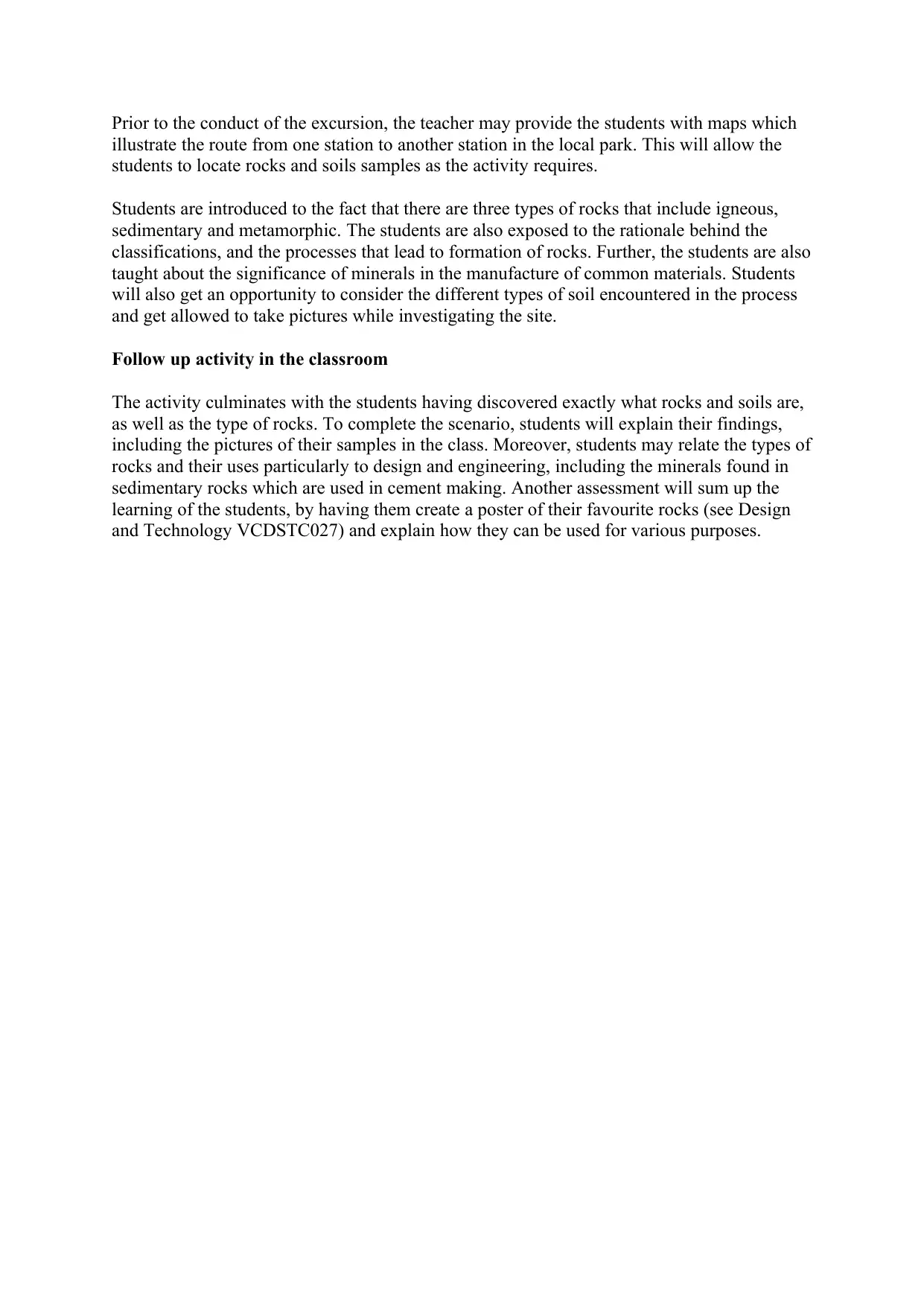
Prior to the conduct of the excursion, the teacher may provide the students with maps which
illustrate the route from one station to another station in the local park. This will allow the
students to locate rocks and soils samples as the activity requires.
Students are introduced to the fact that there are three types of rocks that include igneous,
sedimentary and metamorphic. The students are also exposed to the rationale behind the
classifications, and the processes that lead to formation of rocks. Further, the students are also
taught about the significance of minerals in the manufacture of common materials. Students
will also get an opportunity to consider the different types of soil encountered in the process
and get allowed to take pictures while investigating the site.
Follow up activity in the classroom
The activity culminates with the students having discovered exactly what rocks and soils are,
as well as the type of rocks. To complete the scenario, students will explain their findings,
including the pictures of their samples in the class. Moreover, students may relate the types of
rocks and their uses particularly to design and engineering, including the minerals found in
sedimentary rocks which are used in cement making. Another assessment will sum up the
learning of the students, by having them create a poster of their favourite rocks (see Design
and Technology VCDSTC027) and explain how they can be used for various purposes.
illustrate the route from one station to another station in the local park. This will allow the
students to locate rocks and soils samples as the activity requires.
Students are introduced to the fact that there are three types of rocks that include igneous,
sedimentary and metamorphic. The students are also exposed to the rationale behind the
classifications, and the processes that lead to formation of rocks. Further, the students are also
taught about the significance of minerals in the manufacture of common materials. Students
will also get an opportunity to consider the different types of soil encountered in the process
and get allowed to take pictures while investigating the site.
Follow up activity in the classroom
The activity culminates with the students having discovered exactly what rocks and soils are,
as well as the type of rocks. To complete the scenario, students will explain their findings,
including the pictures of their samples in the class. Moreover, students may relate the types of
rocks and their uses particularly to design and engineering, including the minerals found in
sedimentary rocks which are used in cement making. Another assessment will sum up the
learning of the students, by having them create a poster of their favourite rocks (see Design
and Technology VCDSTC027) and explain how they can be used for various purposes.
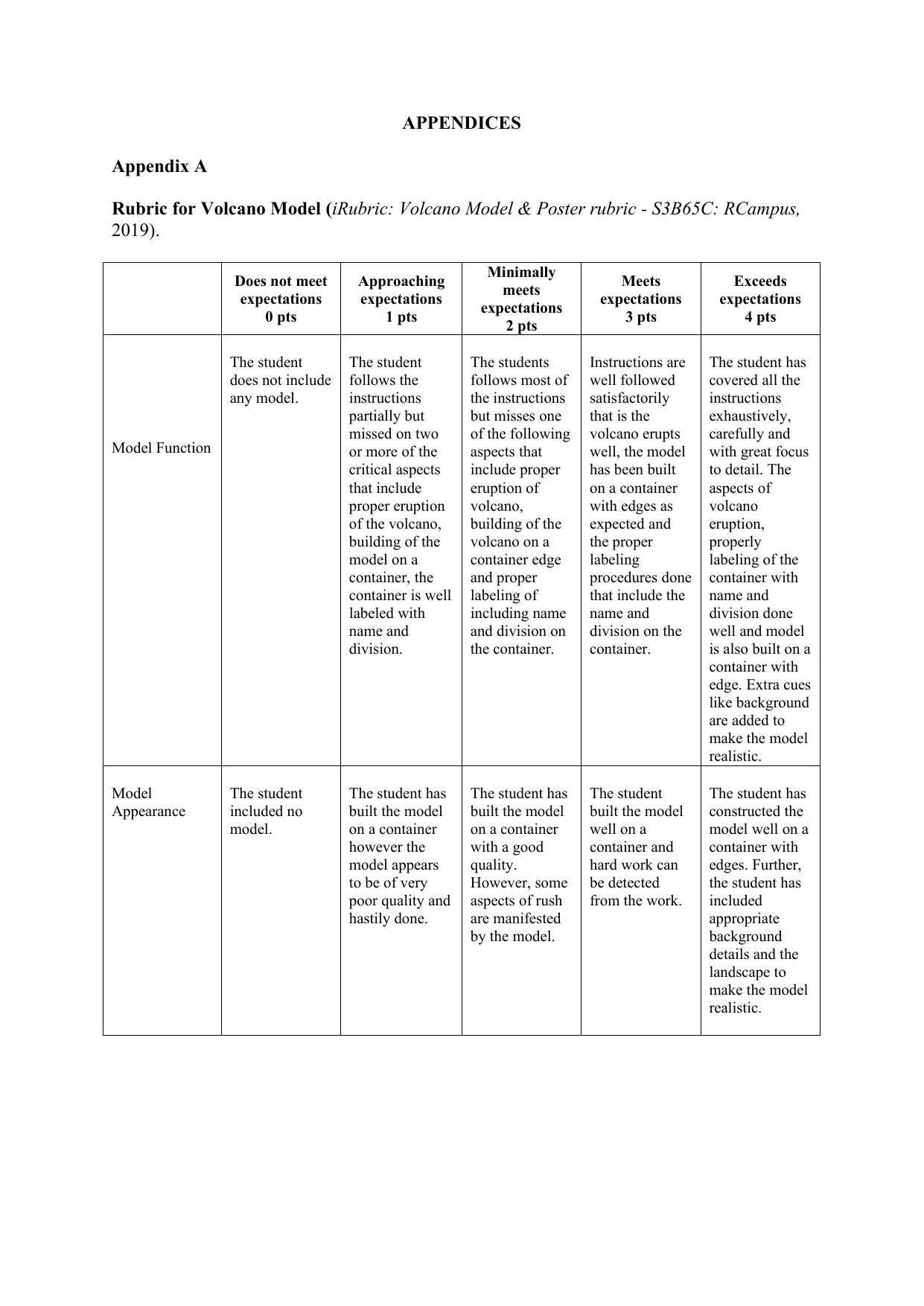
APPENDICES
Appendix A
Rubric for Volcano Model (iRubric: Volcano Model & Poster rubric - S3B65C: RCampus,
2019).
Does not meet
expectations
0 pts
Approaching
expectations
1 pts
Minimally
meets
expectations
2 pts
Meets
expectations
3 pts
Exceeds
expectations
4 pts
Model Function
The student
does not include
any model.
The student
follows the
instructions
partially but
missed on two
or more of the
critical aspects
that include
proper eruption
of the volcano,
building of the
model on a
container, the
container is well
labeled with
name and
division.
The students
follows most of
the instructions
but misses one
of the following
aspects that
include proper
eruption of
volcano,
building of the
volcano on a
container edge
and proper
labeling of
including name
and division on
the container.
Instructions are
well followed
satisfactorily
that is the
volcano erupts
well, the model
has been built
on a container
with edges as
expected and
the proper
labeling
procedures done
that include the
name and
division on the
container.
The student has
covered all the
instructions
exhaustively,
carefully and
with great focus
to detail. The
aspects of
volcano
eruption,
properly
labeling of the
container with
name and
division done
well and model
is also built on a
container with
edge. Extra cues
like background
are added to
make the model
realistic.
Model
Appearance
The student
included no
model.
The student has
built the model
on a container
however the
model appears
to be of very
poor quality and
hastily done.
The student has
built the model
on a container
with a good
quality.
However, some
aspects of rush
are manifested
by the model.
The student
built the model
well on a
container and
hard work can
be detected
from the work.
The student has
constructed the
model well on a
container with
edges. Further,
the student has
included
appropriate
background
details and the
landscape to
make the model
realistic.
Appendix A
Rubric for Volcano Model (iRubric: Volcano Model & Poster rubric - S3B65C: RCampus,
2019).
Does not meet
expectations
0 pts
Approaching
expectations
1 pts
Minimally
meets
expectations
2 pts
Meets
expectations
3 pts
Exceeds
expectations
4 pts
Model Function
The student
does not include
any model.
The student
follows the
instructions
partially but
missed on two
or more of the
critical aspects
that include
proper eruption
of the volcano,
building of the
model on a
container, the
container is well
labeled with
name and
division.
The students
follows most of
the instructions
but misses one
of the following
aspects that
include proper
eruption of
volcano,
building of the
volcano on a
container edge
and proper
labeling of
including name
and division on
the container.
Instructions are
well followed
satisfactorily
that is the
volcano erupts
well, the model
has been built
on a container
with edges as
expected and
the proper
labeling
procedures done
that include the
name and
division on the
container.
The student has
covered all the
instructions
exhaustively,
carefully and
with great focus
to detail. The
aspects of
volcano
eruption,
properly
labeling of the
container with
name and
division done
well and model
is also built on a
container with
edge. Extra cues
like background
are added to
make the model
realistic.
Model
Appearance
The student
included no
model.
The student has
built the model
on a container
however the
model appears
to be of very
poor quality and
hastily done.
The student has
built the model
on a container
with a good
quality.
However, some
aspects of rush
are manifested
by the model.
The student
built the model
well on a
container and
hard work can
be detected
from the work.
The student has
constructed the
model well on a
container with
edges. Further,
the student has
included
appropriate
background
details and the
landscape to
make the model
realistic.
⊘ This is a preview!⊘
Do you want full access?
Subscribe today to unlock all pages.

Trusted by 1+ million students worldwide
1 out of 15
Your All-in-One AI-Powered Toolkit for Academic Success.
+13062052269
info@desklib.com
Available 24*7 on WhatsApp / Email
![[object Object]](/_next/static/media/star-bottom.7253800d.svg)
Unlock your academic potential
Copyright © 2020–2025 A2Z Services. All Rights Reserved. Developed and managed by ZUCOL.